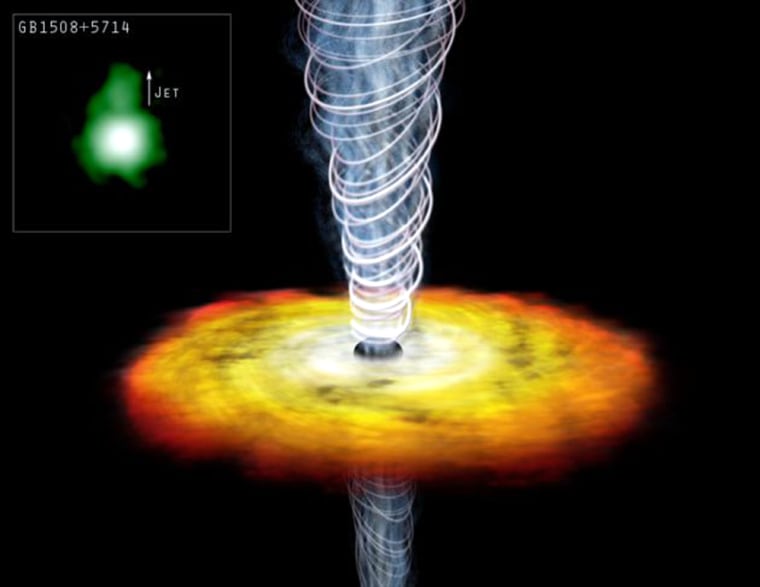Black holes are complex beasts. Among their mysterious traits are intense jets of matter that sometimes shoot out from the rotational poles at nearly light-speed.
The jets are the result of some really twisted physics, according to a new computer model. And to unravel the mystery, a researcher invokes some imaginary string, a corkscrew and a certain child's plaything — the Slinky.
First, the puzzle. At the centers of some galaxies are supermassive black holes that can hold more material than a billion suns, theorists say. From some of these galaxies, focused beams of hot gas shoot into space at more than 99 percent the speed of light. The plasma emits X-rays, radio waves and other radiation, all of which has been widely observed.
Researchers assume the material is accelerated by some mechanism related to the black hole. But there are multiple theories.
One idea is that the spinning of the black hole drags space and time, which twists magnetic field lines and generates a coiled force akin to what allows Tigger to bounce on his tail. Researchers led by Vladimir Semenov of the State University in St. Petersburg, Russia, have created a new computer model that supports this notion.
What's going on?
Semenov's colleague, Brian Punsly of Boeing Space and Intelligence Systems, explained what the team thinks is going on.
Plasma, a superheated gas considered the fourth state of matter, infuses the inner part of a galaxy. Some of it spins into a fairly flat disk around the equatorial region of the central black hole as it gets sucked inward.
"The plasma takes weak strands of magnetic field along for the ride, depositing them near the black hole," Punsly said in an e-mail interview.
This accumulation of magnetized plasma creates a strong magnetic field near the black hole. The lines arc outward like rigid strings that can be envisioned as the skeletal remains of giant space pumpkin. Plasma tends to stick to field lines, effectively forming strings of plasma.
"Plasma sticks to them for the same reason that iron filings trace out a magnetic line of force around a magnet," Punsly said in an e-mail interview. At the heart of the galaxy, all this gets very interesting. "The strings wind around the black hole."
It's a real drag
But this is no simple winding action. The black hole is spinning very fast, and according to Einstein it drags space-time with it. Very close to the black hole, the magnetic field is dragged, "twisting up the strings like a corkscrew," Punsly said. Then it all comes rather undone as the contorted setup propagates out along the black hole's rotational axis, taking the plasma with it.
You can try this at home.
Take a long flexible wire and imagine it is the magnetic string. Try to make a Slinky by twisting one end relative to the other — that's the space-time-dragging force.
"If you try to do this, the wire won't conform to the Slinky's shape," Punsly predicts. "It will try to spring apart. It is a torsional spring. You will feel two forces, one the uncoiling and a second is an expansion force along the axis of the helix that results from trying to compress the individual coils together. If you release your hands it will spring apart axially."
Still up in the air
Roger Blandford, a California Institute of Technology professor who has been theorizing about black hole jets since the 1970s, said the idea that a rotating black hole directly drags the magnetic field, thus accelerating the plasma, is probably the current leading theory for how the jets are produced. "However, the specifics are controversial," he said.
And Blandford and others say there are at least two other processes that could be at work.
The orbiting disk of material coming into the black hole might drag the magnetic field, launching jets from the accretion disk, not from near the hole, explained David Meier, an astrophysicist at NASA's Jet Propulsion Laboratory who has also modeled black-hole jet formation on computers. Or perhaps the black hole drags the disk around, which drags the field around, and thereby indirectly accelerates the jet,
"The field is still very much up in the air," Meier told Space.com.
The problem, of course, is that black holes can't be seen. Even the environments around black holes, being so chaotic and full of energy and bright plasma, thwart close scrutiny. The key to figuring all this out, Meier said, would be to measure black-hole spin rates — something that astronomers don't yet know how to do.
"If we could determine — as we suspect — that black holes with powerful jets are spinning rapidly while those without strong jets are not, then we would at least understand that it is the black-hole rotation that creates the jets," Meier said.
